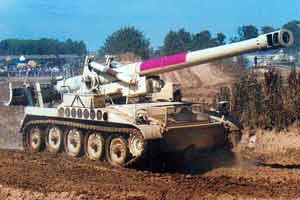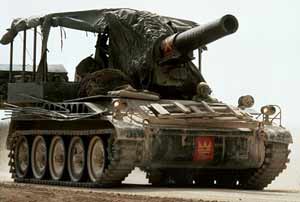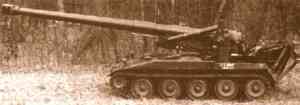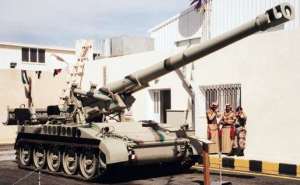| Designation: | M110A2 |
 |
|---|---|---|
| Manufacturer: | BAE Systems Land and Armament | |
| Product type: | Armoured Vehicles | |
| Name: | Self-propelled howitzer |
Future US Army requirements for new heavy artillery emphasised air transportability, time into and out of action, common parts and interchangeability area of fire. A feasibility study encompassing these requirements was carried out, presented and approved at a meeting in January 1956.
The Pacific Car and Foundry Company (subsequently PCF Defense Industries) submitted a concept study for a new family of full-tracked armoured self-propelled weapons and was subsequently awarded a contract for the design, development and construction of six prototype vehicles: two 175 mm self-propelled guns designated the T235, three 203 mm (8 in) self-propelled howitzers designated the T236 and one 155 mm self-propelled gun designated the T245.
Major design features included the interchangeability of the 175 mm gun, 8 in howitzer and 155 mm gun in a common mount, on a common chassis; use of the 8 in howitzer and 155 mm gun field pieces and portions of the M17 standard mount; and drastic reductions in size and weight over conventional equipment which was made possible through a new hydraulic lockout system.
The chassis was also considered suitable for use as a light recovery vehicle and, in 1957, the programme was expanded to include both armoured (T120) and unarmoured (T119 and T121) recovery vehicles.
Ordnance service tests with the first prototype chassis began late in 1958. However, in 1959, a policy was established that diesel rather than petrol engines would be used for future vehicles and three of the prototypes, the T235, T236 and the T120, were retrofitted with Detroit Diesel Model 8V-71T diesel engines and designated the T235E1, T236E1 and the T120E1. Trials with the T235E1 and the T236E1 were completed early in 1961 and in March both vehicles were standardised, the T235E1 as the M107 and the T236E1 as the M110. The T120E1 was subsequently standardised as the M578 ARV (but the T245, T119 and the T121 were not developed further).
In June 1961, the Pacific Car and Foundry Company (which is no longer involved in defence) was awarded an initial production contract for both the M107 and the M110. First production vehicles were completed in 1962 and the first M110 battalion was formed at Fort Sill early in 1963. Production of the M110 was also undertaken at a later date by the FMC Corporation of San José and Bowen-McLaughlin-York (BMY) of York, Pennsylvania. Both these companies merged to become United Defense LP. Today, the latter company is called BAE Systems, Ground Systems. Original production of the M110 was completed in the late 1960s, by which time about 750 vehicles had been produced. In FY78, 209 M110A2s were ordered at a cost of USD109.3 million for delivery from 1979.
The first M110A1 was produced by Bowen-McLaughlin-York in May 1980 (it produced its first M110 during 1965). The first M110A2 was produced in February 1980.
The M110A2 self-propelled howitzer was used by the UK and US ground forces in the 1991 Middle East conflict.
In many countries, for example France, Germany, the UK and the US, the M110A2 has been replaced by the Lockheed Martin Missiles and Fire Control, 227 mm Multiple Launch Rocket System. The main reason the M110 series remained in service for so long was its tactical nuclear capability.
The M110 203 mm (8 in) is operated by a team of 13, five of whom (commander, driver and three gunners) are carried on the gun, with the rest in the M548 tracked cargo carrier which also carries the ammunition. The M548 unarmoured full-tracked carrier shared many common components with the now BAE Systems, Ground Systems M113 series of full-tracked armoured personnel carriers. Production of the M548 was completed some time ago.
The hull of the M110 is identical to that of the M107 and is made of all-welded armour and high-tensile alloy steel with the driver at the front of the hull on the left, the power pack to his right and the main 203 mm (8 in) armament at the rear.
The driver, who is the only member of the crew to be seated under armour, has a single-piece hatch cover in front of which are three M17 day periscopes. The middle M17 day periscope can be replaced by a passive night vision device. The Detroit Diesel Model 8V-71T engine is coupled to the Allison Transmission XTG-411-2A cross-drive transmission at the front of the hull.
The torsion bar suspension either side consists of five dual rubber-tyred road wheels with the drive sprocket at the front and the fifth road wheel acting as the idler. There are no track-return rollers. Attached to each road wheel is a hydraulic cylinder that serves as a shock-absorber, a hydraulic bump stop and a suspension lockout which transmits recoil shock directly to the ground. The tracks are of the single-pin type with removable rubber pads.
The M110 has night vision equipment but no NBC system or amphibious capability.
The M110 is armed with a 203 mm (8 inch) M2A2 howitzer in an M158 mount and has an elevation of +65°, a depression of -2° and a traverse of 30° left and right. Elevation, depression and traverse are hydraulic with manual controls for emergency use. The weapon has a hydropneumatic recoil system, an interrupted screw breech block and a percussion firing mechanism. Mounted at the rear of the chassis on the left side is a rammer and loader assembly which lifts a projectile from the rear or left side of the vehicle, positions it and rams it into the chamber. Hydraulic power for operating the system is obtained from the vehicle's system but it can also be operated by handcranks. Mounted at the rear of the chassis is a large hydraulically operated spade that is lowered into position before firing begins.
The 8 in (203 mm) weapon fires the following types of conventional ammunition:
- HE (M106) with the projectile weighing 92.53 kg, a maximum muzzle velocity of 587 m/s and a maximum range (charge 7) of 16,800 m
- HE (M404) (carries 104 M43A1 grenades) with a projectile weighing 90.72 kg, a maximum muzzle velocity of 587 m/s and a maximum range (charge 7) of 16,800 m
The ammunition is separate loading. Two rounds are carried on the vehicle and the rest in the supporting vehicle. The normal rate of fire is one round every two minutes but two rounds a minute can be fired for short periods.
Fire-control equipment consists of a panoramic sight M115 (magnification of ×4 and 10° field of view) for indirect fire, telescope M116C (magnification of ×3 and 13° field of view) for direct fire, elevation quadrant M15 and gunner's quadrant M1A1.
In 1969, the United States Army Armament Command began the development of a new version of the M110, which would have a longer range and fire new types of improved 203 mm ammunition. This was standardised as the M110A1 in March 1976 and entered service in January 1977. The M110A1 replaced both the M110 and M107, which were phased out of service with the US Army in Europe by 1980. It then cost less than USD100,000 to convert the M107/M110 to the M110A1/M110A2 standard.
The M110A1 has a new and much longer 203 mm barrel called the M201, a direct fire elbow telescope, the M139, and a chassis identical to the M110's. The M110A2, which was standardised in 1978, is the M110A1 fitted with a double-baffle muzzle brake and can fire charge 9 of the M118A1 propelling charge whereas the earlier M110A1 can fire only up to charge 8. The weapon can fire the following projectiles:
- HE (M106) with the projectile weighing 92.53 kg, a maximum muzzle velocity of 711 m/s and a maximum range (charge 8) of 22,900 m
- HE (M404) with the projectile weighing 90.72 kg, a maximum muzzle velocity of 711 m/s and a maximum range (charge 8) of 17,200 m. This is also referred to as an Improved Conventional Munition and carries 104 anti-personnel grenades
- HE (M509A1) carrying 180 anti-personnel/anti-materiel grenades with a maximum range (charge M188A1) of 22,900 m. This is also referred to as an Improved Conventional Munition and carries dual-purpose grenades
- HERA (M650) with a maximum range (charge 9) of 30,000 m
|
||||||||||||||||||||||||||||||||||||||||
|
|||||||||
|
|||||||||||||||||||||||||||||||||
 |
 |
 |
 |
 |







